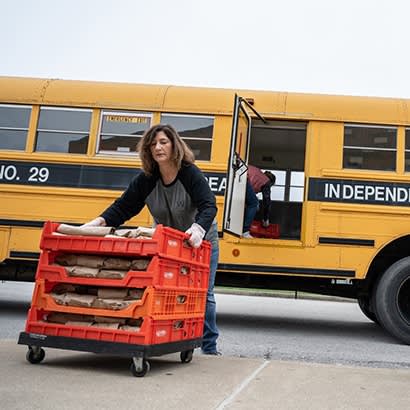


2. NRPA, 2021 NRPA Engagement with Parks Report.
3. U.S. Department of Health and Human Services. (2018). 2018 Physical Activity Guidelines Advisory Committee Scientific Report. Physical Activity Guidelines Advisory Committee.
4. Hughey, S. Morgan, et al. (2021). “Frequency of neighborhood park use is associated with physical activity among adults in four US cities.” Journal of physical activity and health 18.5 (2021): 603-609.
5. Giles-Corti, Billie, et al. “Increasing walking: how important is distance to, attractiveness, and size of public open space?” American Journal of Preventive Medicine 28.2 (2005): 169-176.
6. Twohig-Bennett, Caoimhe, and Andy Jones. “The health benefits of the great outdoors: A systematic review and meta-analysis of greenspace exposure and health outcomes.” Environmental research 166 (2018): 628-637.
7. Bikomeye, Jean C., et al. “Resilience and equity in a time of crises: investing in public urban greenspace is now more essential than ever in the US and beyond.” International journal of environmental research and public health 18.16 (2021): 8420.
8. Alexander, Dayna S., et al. “The association between recreational parks, facilities and childhood obesity: a cross-sectional study of the 2007 National Survey of Children's Health.” Journal of Epidemiology & Community Health 67.5 (2013): 427-431.
9. U.S. Department of Agriculture, Forest Service. (2018). Urban Nature for Human Health and Well-Being. FS-1096. Washington, D.C.
10. Reuben, Aaron, et al. “Association of Neighborhood Parks with Child Health in the United States.” Preventive Medicine 141 (2020): 106265.
11. Carlson, Susan A., et al. (2015). “Inadequate Physical Activity and Health Care Expenditures in the United States.” Progress in Cardiovascular Diseases 57.4 (2015): 315-323.
12. Coughlan, Diarmuid, et al. “Leisure time physical activity throughout adulthood is associated with lower Medicare costs: evidence from the linked NIH-AARP diet and health study cohort.” BMJ Open Sport & Exercise Medicine 7.1 (2021): e001038.
13. US Department of Health and Human Services. Physical Activity Guidelines for Americans. 2nd ed. Washington, DC: US Dept of Health and Human Services; 2018.
14. NRPA, 2021 NRPA Agency Performance Review.
15. NRPA, Advancing Community Health and Well-Being.
16. Barrett MA, Miller D, Frumkin H. (2014). “Parks and Health: Aligning Incentives to Create Innovations in Chronic Disease Prevention.” Preventing Chronic Disease 2014;11:130407.
17. Active Living Research. Making the Case for Designing Active Cities.
18. Sturm, Roland, and Deborah Cohen. “Proximity to urban parks and mental health.” The journal of mental health policy and economics 17.1 (2014): 19.
19. Wood, Lisa, et al. (2017). “Public green spaces and positive mental health–investigating the relationship between access, quantity and types of parks and mental wellbeing.” Health & Place 48 (2017): 63-71.
20. Larson, Lincoln R., Viniece Jennings, and Scott A. Cloutier. “Public parks and wellbeing in urban areas of the United States.” PLoS One 11.4 (2016): e0153211.
21. NRPA, 2021 NRPA Out-Of-School Time Report
22. NRPA, 2021 NRPA Agency Performance Review.
23. NRPA, Youth Sports at Park and Recreation Agencies report
24. NRPA, 2018 NRPA Out-of-School Time Report
25. Bowers, Edmond P., Lincoln R. Larson, and Benjamin J. Parry. “Nature as an Ecological Asset for Positive Youth Development: Empirical Evidence From Rural Communities.” Frontiers in Psychology 12 (2021): 2159.
26. Evans, Gary W., Siegmar Otto, and Florian G. Kaiser. “Childhood origins of young adult environmental behavior.” Psychological Science 29.5 (2018): 679-687.
27. NRPA, Connecting Youth to Nature Survey
28. DeVille, Nicole V., et al. “Time Spent in Nature Is Associated with Increased Pro-Environmental Attitudes and Behaviors.” International Journal of Environmental Research and Public Health 18.14 (2021): 7498.
29. Strife, Susan, and Liam Downey. “Childhood development and access to nature: A new direction for environmental inequality research.” Organization & Environment 22.1 (2009): 99-122. https://pubmed.ncbi.nlm.nih.gov/21874103/
30. Beery, Thomas. “Exploring access to nature play in urban parks: resilience, sustainability, and early childhood.” Sustainability 12.12 (2020): 4894.
31. Razani, Nooshin, et al. “Clinic and park partnerships for childhood resilience: A prospective study of park prescriptions.” Health & place 57 (2019): 179-185.
32. NRPA, The Economic Impact of Parks
33. Bureau of Economic Analysis. (2021). Outdoor Recreation Satellite Account, U.S. and States, 2020.
34. U.S. Census Bureau. Annual Survey of Public Employment & Payroll (ASPEP) 2020.
35. Gambale, Geraldine. (2022). “36th Annual Survey of Corporate Executives Commentary: Supply Chain Factors Take on Added Significance.” Areas Development Magazine.
36. NRPA, Promoting Parks and Recreation’s Role in Economic Development
37. Crompton, John L. and Nicholls, Sarah. (2020). “Impact on property values of distance to parks and open spaces: An update of U.S. studies in the new millennium.” Journal of Leisure Research, 51:2, 127-146.
38. NRPA, Workforce Development and Career Exploration at Parks and Recreation
39. NRPA, 2019 Engagement with Parks Report
40. September 2019 NRPA Park Pulse
41. Leavell, M. A., et al. “Nature-based social prescribing in urban settings to improve social connectedness and mental well-being: a review.” Current Environmental Health Reports 6.4 (2019): 297-308.
42. NRPA, 2020 NRPA Engagement with Parks Report
43. October 2020 NRPA Park Pulse
45. April 2021 NRPA Park Pulse
46. NRPA, Greener Parks for Health Communications Toolkit
47. Nowak, David, and Gordon Heisler. (2010). Air quality effects of urban trees and parks. Research Series Monograph. NRPA. 44 p. (2010): 1-44.
48. Tempesta, Tiziano. “Benefits and costs of urban parks: A review.” Aestimum (2015): 127-143.
49. Villeneuve, Paul J., et al. “A cohort study relating urban green space with mortality in Ontario, Canada.” Environmental Research 115 (2012): 51-58.
50. Hartig, Terry, et al. “Associations between greenspace and mortality vary across contexts of community change: a longitudinal ecological study.” Journal of Epidemiol Community Health 74.6 (2020): 534-540.
51. March 2022 NRPA Park Pulse
52. April 2022 NRPA Park Pulse
53. Jackson, S. Brent, et al. “Outdoor activity participation improves adolescents’ mental health and well-being during the COVID-19 pandemic.” International Journal of Environmental Research and Public Health 18.5 (2021): 2506.
54. February 2022 NRPA Park Pulse
55. Mullenbach, Lauren E., et al. “Cultivating social capital in diverse, low-income neighborhoods: The value of parks for parents with young children.” Landscape and Urban Planning 219 (2022): 104313.
57. March 2023 NRPA Park Pulse poll: Parks and Recreation Provides Youth Sports Opportunities for All